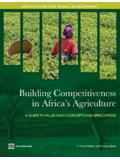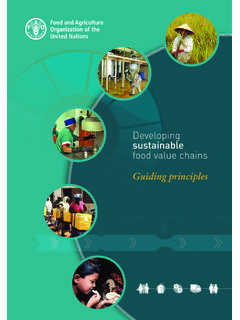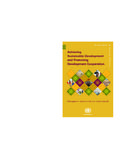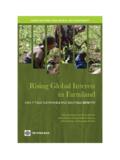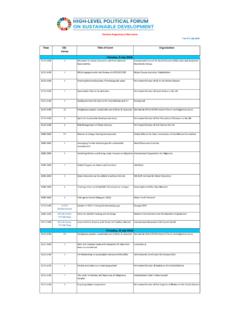Transcription of USING VALUE CHAIN APPROACHES IN …
1 USING VALUE CHAIN APPROACHES IN agribusiness AND agriculture IN SUB-SAHARAN AFRICA A METHODOLOGICAL GUIDE Tools That Make VALUE Chains Work: Discussion and Cases Prepared for the World Bank Austin Associates, Inc. Principal Author: Martin Webber, Austin Associates, Inc. Program Director: Patrick Labaste, The World Bank i Acknowledgements This Guide was prepared by Austin Associates for the Sustainable agriculture Group of the World Bank.
2 The work was directed by Mr. Patrick Labaste of the World Bank. The Principal Author and team leader was Mr. Martin Webber, Executive Vice President of Austin Associates, Inc. Principal contributors and coauthors from Austin Associates included Marcos Arocha, Virginia Brandon, Lisa Carse, Grant Cavanaugh, Michael Ducker, David Feige, Michael Gorman, Carlton Jones, Jennifer Lynch, Jane Shearer, Justin Stokes, and Gina Tumbarello. Principal World Bank collaborators were Malick Antoine and Jean-Luc Bosio. Jean Michel Voisard also served as reviewer.
3 The authors convened a roundtable of industry experts, who provided suggestions and experiences that enhanced this Guide. The roundtable participants included : Graeme Dixie, Richard Henry, Steve Jaffee, Svetlana Meades, Paul Siegel, Yolanda Strachan and Uma Subramanian of the World Bank Group ; and Susan Bornstein (TechnoServe), Jeanne Downing (USAID), Paul Guenette (ACDI-VOCA), Olaf Kula (ACDI-VOCA), John Lamb (Abt), Frank Lusby (Action for Enterprise) and Lynn Salinger (AIRD). Many, many people contributed their expertise and experience, particularly to the case studies.
4 They shared their own stories, and their analyses and observations. Their personal experiences and generous willingness to share their stories and conclusions make this Guide a particularly rich source of ideas and information. We sincerely apologize for any omissions, which, of course, are inadvertent. _____ _____ ii Table of Contents vii Section 1: Agricultural VALUE Chains and Africa s Development Agenda ..1 Opportunities and Threats of Trade and Market Globalization for African Economies2 Comparison of Agricultural Productivity.
5 4 Objectives of the Guide ..6 Organization of the Section 2: Concepts and Definitions of VALUE Chains/Supply Chains ..9 VALUE Chains: Definition of Concepts ..9 How VALUE - CHAIN Analysis Has Been Analyzing and Evaluating VALUE Chains ..11 Limitations of VALUE CHAIN Implications of the Operating Environment: Beyond the VALUE CHAIN ..14 Section 3: Review of Existing Literature on VALUE /Supply Summary of General Themes and Structure from the Literature Review ..20 Creating Trust ..20 Governance: What Type of Power Relationship Exists and Is Information Shared?22 Market or Bargaining Power (Buyer vs.)
6 Producer) ..23 Innovation, Information, Information Sharing, and Knowledge ..25 Intervention Entry Points and Initial Focus ..26 Section 4: Discussion of Individual Tools ..28 Introduction and Overview ..28 Theme One: Designing strategies and business plans Obtaining and USING Theme Two: Developing robust new Theme Three: Supplying the market Aligning supply to match market opportunity28 Theme Four: Reaching the market Market positioning and market opportunities ..29 Theme Five: Improving the business and policy environment ..29 Theme Six: Building partnerships ..29 Theme Seven: Monitoring results in VALUE CHAIN Tool 1: Choosing Priority Sectors for VALUE CHAIN Interventions.
7 32 Initial iii Box 1: How to Choose VALUE Chains for Intervention: The Example of Senegal's Project Croissance Economique ..34 Market Analysis ..35 Domestic Capacity and Economic Impact ..35 Testing Commitment ..35 A Step-by-Step Summary of Tool 1: Choosing Priority Sectors for VALUE CHAIN Interventions ..36 Case Study: Prioritizing VALUE Chains by USING Comparative Analysis VALUE CHAIN Selection in Mozambique.
8 37 Case Study: Geomar - Innovative APPROACHES to Assessing the Competitiveness of VALUE Chains ..43 Tool 2: Designing Informed Strategies Across the VALUE CHAIN ..43 Enhancing VALUE CHAIN Assessing the Overall Status of the VALUE Assessing Strategic Assessing Operational Productivity ..48 Assessing the Quality of Supply CHAIN Assessing Human Resources Across the VALUE CHAIN ..50 Assessing the Business Case Study: Understanding the VALUE CHAIN and Integrating Information Into Strategy: Nigerian Domestic 52 Tool 3: Conducting Benchmarking and Gap Assessments of VALUE Chains.
9 59 Benchmarking Background ..59 The Benchmarking Tool ..59 Box 2: Uganda Benchmarking Constraints in the Coffee Industry ..61 Box 3: Tanzania Cotton Benchmarking A Step-by-Step Summary of Tool 3: Conducting Benchmarking and Gap Assessments of VALUE Chains ..66 Case Study: Uganda Floriculture: Benchmarking and Gap Analysis ..68 Tool 4: Upgrading and Deepening the VALUE CHAIN ..76 Deepening Through Adding Operations ..76 Box 4: Mongolian Meat Industry Upgrading the VALUE CHAIN ..77 Methods for Deepening the VALUE Box 5: Deepening the VALUE CHAIN : Glass Jar Production in Armenia.
10 79 iv Conclusion ..80 Case Study: Kenyan Green Beans and Other Fresh Vegetable Exports ..81 Tool 5: Identifying Business Models for Replication ..85 Box 6: Replicable Business Models - Rwanda Coffee Washing Box 7: Dairy Pakistan Identifying and Replicating Business Models within the VALUE CHAIN ..86 A Step-by-Step Summary of Tool 5: Identifying Business Models for Replication ..87 Case Study: Identifying and Implementing Replicable Business Models-Mozambique Cashews ..88 Tool 6: Capturing VALUE Through Forward and Backward Integration ..92 Vertical Integration from the National VALUE CHAIN Perspective.

